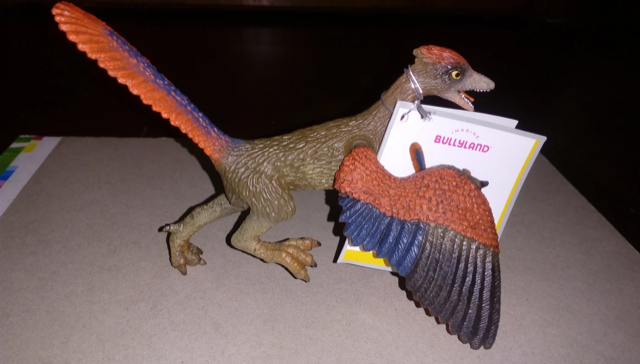Many of Bullyand’s figures have yet to be covered here on the Dinosaur Toy Blog as of this writing. The subject of this review, their 2000 Allosaurus, is actually my first piece from the company. Allosaurus remains a mainstay in dinosaur merchandise today, with a wide range of pieces in varying degrees of quality, but at the turn of the century, this Walking With Dinosaurs-inspired offering would have been one of the best among a much smaller pool of choices.
Brand: Bullyland
Review: Parasaurolophus (2007)(Bullyland)
Review: Woolly Mammoth (Museum Line by Bullyland)
Review: Giganotosaurus (Bullyland)

Review: Archaeopteryx (version 1)(Museum Line by Bullyland)

Our recent review of the 2017 Bullyland Archaeopteryx prompted me to search through the Dinotoyblog archives to compare the new version with the old…only to discover that we’ve never reviewed the original Bullyland Museum Line Archaeopteryx. That immediately helped me settle on which figure to review next.
Review: Archaeopteryx (version 2, 2017)(Museum Line by Bullyland)
Review: Smilodon (Bullyland)

Bullyland is well known for its range of prehistoric animal models for an old museum line, which is now sadly discontinued. One week ago, I saw many Bullyland figures put on sale at my local toy shop; there were modern animal figures and some prehistoric ones that are still in production.
Review: Medusa (Bullyland)

Today I want you to introduce you to one of those creatures everybody knows, but knows almost nothing about, a jellyfish. Jellyfish are a very very old group of animals, they date back to the famous Ediacarian, more than 600 mya.
Review: Megatherium (Bullyland)

Review: Ammonit (Bullyland)

As promised, here’s the follow up to the recent Bullyland “Belemnit” review, another take of German company Bullyland to prehistoric molluscs. Another, you’d ask? Yes, while most toy companies do not bother with prehistoric molluscs at all or just did so very recently (as Safari, Schleich or CollectA), Bullyland dashed out this, said “Belemnit” and yet another “Ammonit” as early as 1998.
Review: Belemnit (Bullyland)

Review: Pachycephalosaurus (Bullyland)

During this seasonal, festive, frenzy of reviews, lets take a small time warp back in time and bring forth a toy that has been left behind by the relentless march of time. In 2009, Bullyland, the purveyor of goofy eyed yet expressive figures, released a interesting looking Pachycephalosaurus.







